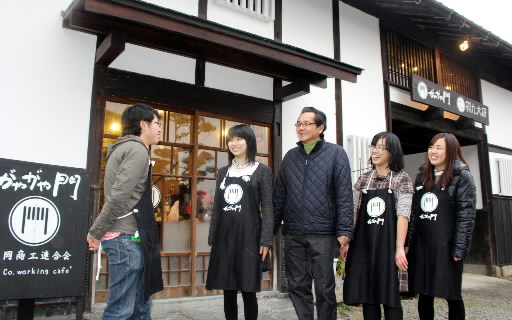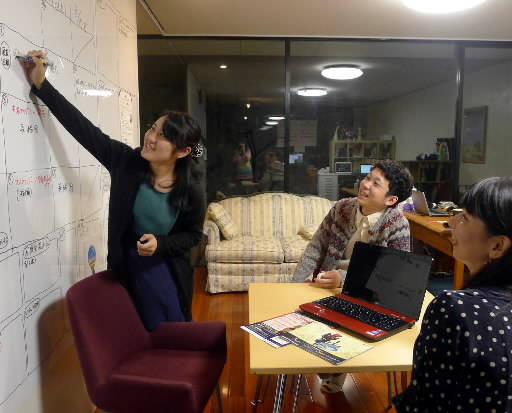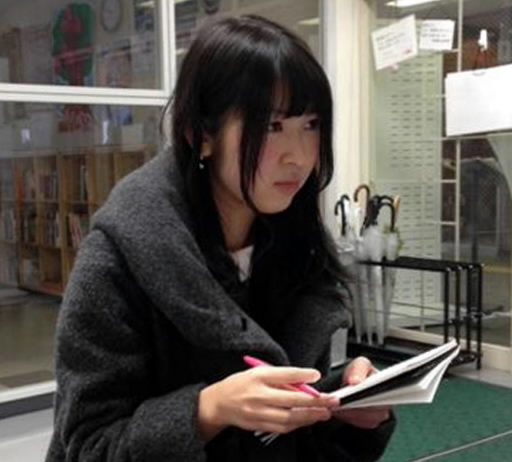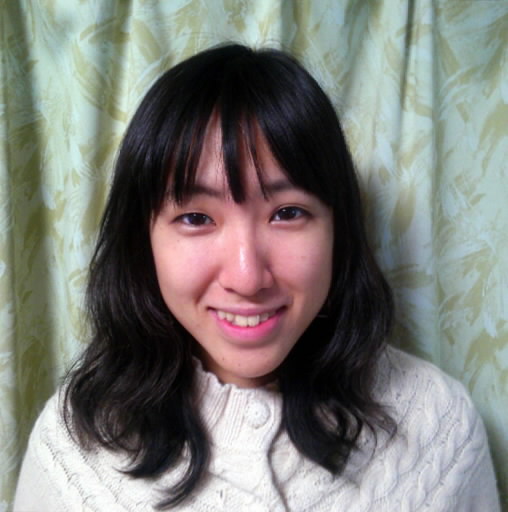Former junior writers, active in the world as college students
Jan. 21, 2014
by Rie Nii and Sakiko Masuda, Staff Writers
Seven years have now passed since the Chugoku Shimbun’s program of “junior writers,” who report on peace issues and organize peace-related events, was established. Including the 24 current members of the group, from the 6th grade of elementary school to the second year of high school, a total of 77 students from Hiroshima schools have taken part. Former junior writers who are now college students, in a variety of locations, are making use of their experience with the newspaper in Hiroshima as they pursue a wide range of activities.
Minako Iwata in Fukuoka: Managing a café that brings people together
Amid the countryside near the Ito Campus of Kyushu University, in Nishi Ward, Fukuoka City, is a café called “Gayagayamon.” On the chilly night of December 21, 2013, about 20 students and families with children gathered at the café to enjoy pots of nabe (Japanese stew) with fresh vegetables grown locally and other dishes prepared by area residents. There were smiles all around.
Minako Iwata, 20, is the leader of the group that manages the café. Now a sophomore at Kyushu University, Minako is originally from Minami Ward, Hiroshima and is a former junior writer. Speaking in front of the participants at the gathering, she said, “I want to strengthen ties among the people of this area.” The participants then had the chance to share their studies at college and their dreams for the future.
The café opened in April 2013, in the office of the local Motooka Federations of Societies of Commerce and Industry, to provide opportunities for college students to meet and interact with the local residents. Every third Saturday of the month, they hold the kind of gathering that took place last December.
Kyushu University began shifting its departments to the new Ito Campus in 2005. Although the number of students living near the new campus has increased, there has been little opportunity to socialize with local residents. The university hopes to become a part of the community by pursuing such efforts as the café, which serves light meals and offers events like cooking classes, with local mothers as instructors.
Toshiaki Kumagaya, 60, the head of the Motooka Federations of Societies of Commerce and Industry, took part in the December gathering. “We wanted to make connections with the students, but we didn’t have a good way to do this,” he said. “I now want to make good use of the ties that have formed at the café and work together to revitalize this area.”
Minako served as a junior writer for more than five years. She believes that “Cherishing the ties between people, like the work we do at the café, can help promote peace in the world.” In the future, she dreams of working to help address the global problems of hunger and poverty.
Yuki Sakata in Tokyo: Screening films for children in Fukushima
Since the end of July 2013, Yuki Sakata, 20, originally from Naka Ward, Hiroshima and now a freshman at Komazawa University in Tokyo, has been working as an intern at the office of Tokyo Kinder Film, which screens movies for children. Last November, Yuki was involved in an effort to organize a screening in the city of Soma in Fukushima Prefecture, to support those suffering as a result of the earthquake, tsunami, and nuclear accident that hit the Tohoku region in March 2011.
From the days she served as a junior writer at the Chugoku Shimbun, Yuki said she found that film can deliver a powerful message for peace. She believes that children can learn a range of things from movies that will help broaden their view of the world. Because she also enjoys volunteering, she decided to take part.
At Kinder Film, she is involved in obtaining the rights of films from other countries, handling requests for screenings from places in Japan, making proposals for screening events, and other tasks. At the screening in Fukushima Prefecture in November, which was the third screening by Kinder Film since the Great East Japan Earthquake, she distributed flyers at elementary schools and junior high schools in the Soma area and visited the venue in advance to check the setting. On the day of the event, voice actors and actresses who had been invited to take part provided Japanese dubbing for the film.
“I hope that parents and their children will watch good films together and talk about their impressions later at home,” Yuki said.
Kana Kumagaya in Kyoto: Working at a university newspaper
Originally from Nishi Ward, Hiroshima, Kana Kumagaya, 19, a freshman at Ritsumeikan University, is a member of a newspaper group at her university. Along with eight other universities, the group of student-journalists at Ritsumeikan University are part of the “University News Network Kansai,” which consists of about 70 members and publishes a newspaper for students living in the Kansai region five times a year and provides news and information online as well.
The newspaper offers a variety of articles pertaining to student life, and includes two pages covering activities at Ritsumeikan University.
Recently, through a friend, she learned about two other freshmen at her school who have founded a new club activity. She interviewed the two students and said that she came away inspired by the passion showed by her peers.
This month the newspaper will feature a section on studying abroad. This was Kana’s idea and she’s spearheading the effort. “I want to highlight the fact that some students go abroad without a clear purpose and then return to Japan without accomplishing much,” she explained.
While serving as a junior writer, Kana encountered a range of people through her interviews and took part in a variety of activities. These enjoyable experiences led to her join the newspaper group at her university. “We aren’t hired by the university, or paid any wages, so we’re free to include criticism in our work,” she said. “I hope to do more interviews that will be of interest to our readers.”
Chisa Nishida in Nagasaki: Hoping to help address nuclear issues
Chisa Nishida, 19, is from Nishi Ward, Hiroshima. Now a freshman at Nagasaki University, in the city of Nagasaki, she traveled to Kazakhstan last summer with a group of teachers and students. They visited the largest nuclear test site run by the former Soviet Union and saw animals that had been harmed by nuclear testing and were preserved in formalin. In a neighboring village, they heard a resident tell the story of how he had lived in the village for decades, without receiving any information about the conditions there. He lost one child after another to poor health and developed cancer himself numerous times.
“There are people who have been harmed by nuclear weapons in many parts of the world, not only in Hiroshima and Nagasaki,” said Chisa. “I want to help resolve these nuclear issues by working together with other people, beyond borders.” Her goal is to learn how radiation impacts the human body, from a medical standpoint, and convey this information to others in the world.
As a junior writer, she pondered the atomic bombing of Hiroshima. Today, she lives in the other A-bombed city, Nagasaki. Chisa also hopes she can help young people in both cities come together to discuss peace issues.
◇
Other former junior writers are pursuing various activities, too.
Reika Konno, 19, is studying to become a nurse. “It’s a mountain of work,” she said. In February, she will begin her full-time practical training. Seira Furukawa, 20, is a junior at a U.S. university in the state of Missouri. Akane Murashige, 20, is also studying in the United States, at a university in the state of Ohio.
Aoi Otomo, 19, is studying painting in college, and Sayaka Azechi, 19, is studying modern art. Shotaro Takada, 19, is involved in Yosakoi dance at his university, and Shiori Ueki is learning flamenco dance. Shiori Kusuo, 20, has been researching town planning in a class at her university. Before she graduates in March 2015, she is researching the history of the local professional baseball team, known as the Hiroshima Carp, under the theme of “Hiroshima Prefecture and the Hiroshima Toyo Carp.” The team was founded after the atomic bombing with public support, without a parent company, and Shiori is looking into the connection between the public and the team as a precedent for professional sports based on the support of the community. She also plans to make proposals about the team’s prospects for the future.
Risa Kushioka, 22, will start working this spring in the marketing department of a car manufacturer. She will make good use of her experience as a university student, where she was involved in a “Model United Nations” group, taking part in a conference on climate change and nuclear disarmament and interacting with international students as a Japanese representative to a conference held by Japan, China, and Korea. Meanwhile, Shoko Tagaya, 23, and Kyoko Niiyama, 24, found employment and began working last spring.
(Originally published on January 6, 2014)










